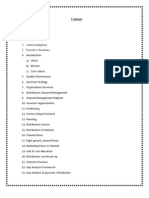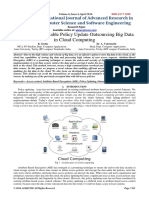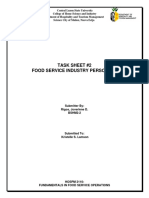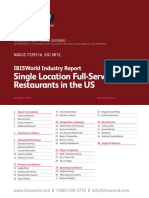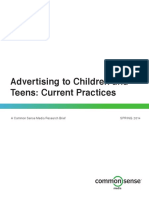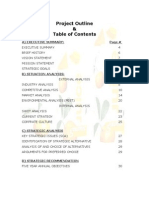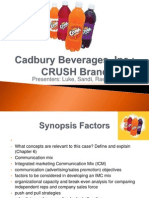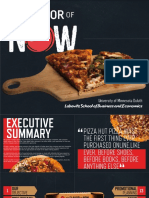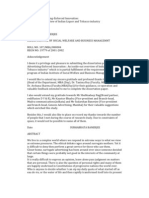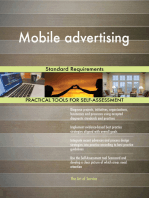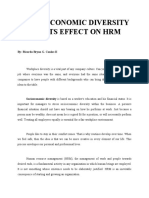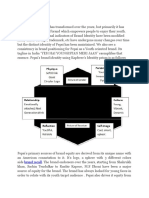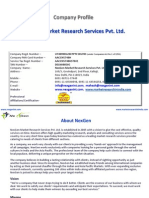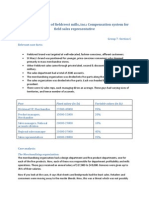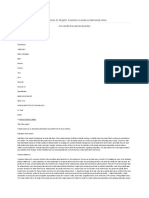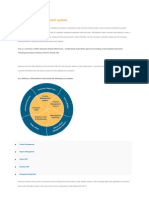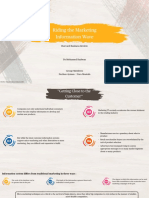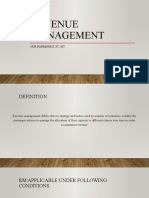Monty Marketing Imc Plan For Applebees Final Version
Monty Marketing Imc Plan For Applebees Final Version
Uploaded by
api-457180603Copyright:
Available Formats
Monty Marketing Imc Plan For Applebees Final Version
Monty Marketing Imc Plan For Applebees Final Version
Uploaded by
api-457180603Original Title
Copyright
Available Formats
Share this document
Did you find this document useful?
Is this content inappropriate?
Copyright:
Available Formats
Monty Marketing Imc Plan For Applebees Final Version
Monty Marketing Imc Plan For Applebees Final Version
Uploaded by
api-457180603Copyright:
Available Formats
Applebee’s Services, Inc.
Fresh & Locally Sourced Ingredients
Integrated Marketing Communications Plan
January 1, 2019 – December 31, 2019
Created by Monty Marketing
Andrea Mingels, Blair Ritter, Brian Gibbons, Jenna Clark, Tran Truong
James Madison University
Marketing 384, Section 1
Professor Canessa Collins
December 4, 2018
Table of Contents
Our Philosophy __________________________________________________3
1.0 Executive Summary____________________________________________ 4
2.0 Overview of Marketing Plan __________________________________5 - 12
2.1 Industry Background_____________________________________________5
2.2 Company Snapshot__________________________________________5
2.3 Description_____________________________________________6 - 7
2.4 Competitive Review_________________________________________8
2.5 Buyer Analysis _________________________________________9 - 11
2.6 Marketing Goals___________________________________________12
2.7 Communication Objectives___________________________________12
3.0 Promotional Program Situation Analysis____________________________13
3.1 Existing/Past Programs__________________________________________13
3.2 IMC Objectives & Strategies _________________________________13
3.3 Creative Recommendations _______________________________14 - 15
3.4 Media Recommendations____________________________________16
3.5 Media Mix Recommendations & Rationale ___________________ 16 - 17
3.6 Media Flowchart __________________________________________18
3.7 Budget Breakdown _____________________________________19 - 20
3.8 Sales Promotions Recommendations ___________________________21
3.9 Direct Marketing Recommendations ___________________________ 22
3.10 Internet/Interactive Recommendations _________________________ 23
3.11 Public Relations Recommendations ___________________________ 24
3.12 Campaign Flowchart ______________________________________25
3.13 Measurement & Evaluation ______________________________26 - 27
3.14 Budget Summary _________________________________________28
4.0 Conclusion __________________________________________________29
5.0 Appendices ______________________________________________30 - 39
References _____________________________________________________ 40
Copyright © 2018 Monty Marketing
Our Philosophy
“If you change the way you look at things,
the things you look at change”
–Wayne Dyer
In a society where perception is everything, you
and your business need to feel confident in
knowing that your brand image is in good hands.
Here at Monty Marketing, we make it our business
to ensure that your brand image receives the
dedication and care that it deserves. We strive to
provide clients with a personalized and effective
communications plan that will reach the right
people at the right time in the best way possible.
We pride ourselves on the strong bonds we create
and sustain with our clients, which allows us to
gain an in-depth knowledge about their industry
and the goals they wish to achieve within it. No
matter how big or small a client is, Monty
Marketing treats each one with the utmost
respect and level of dedication.
Sincerely ,
Copyright © 2018 Monty Marketing
1.0 Executive Summary
Major Target Audience:
Applebee’s currently has a primary target market consisting of Gen X and Baby
Boomers (ages 34 and older) and a secondary target market of Millennials and Gen Z.
The marketing plan focuses primarily on the secondary target market of ages 34 and
below. These generations tend to be more money and health conscious, and seek out
unique experiences when dining out, such as seasonal menu items or entertainment.
Time Period of the Plan:
Monty Marketing has developed this IMC plan for the year 2019, beginning January 1,
2019 and ending December 31, 2019. This year-long IMC plan for Applebee’s is broken
into the following: research, planning, execution, and then evaluation. As predicted, the
elements of this IMC plan are expected to last approximately 365 days. Monty
Marketing will work alongside Applebee’s, creating a partnership to conduct extensive
market research, develop strategies based on set objectives, providing ad
recommendations on execution, as well as a follow-up evaluation to measure the
success of the plan.
Campaign Objectives:
Monty Marketing’s overall IMC objective is to increase Applebee’s sales by 30% during
January 1, 2019 to December 31, 2019. This will be accomplished by placing a focus on
using healthy, fresh, and local ingredients, and by establishing several communications
objectives that will focus on increasing awareness, knowledge, liking/attitude, and
preference for Applebee’s among our target audiences. In order to achieve each of
these objectives, numerous marketing mediums and vehicles will be used to promote
Applebee’s. As a result of accomplishing the communication objectives, Applebee’s
hopes to achieve their overall marketing goal of increasing sales by 30% over the next
year.
Campaign Theme:
The theme of this marketing campaign is “healthy, fresh, and right from your
neighborhood.” Applebee’s will begin sourcing their ingredients from local farms to help
ensure healthy, better quality food. The restaurant will also begin to incorporate more
gluten free, vegetarian, and vegan menu options. We want consumers to reimagine
Applebee’s as a health focused restaurant that cares about the quality and freshness of
their food.
Overall Budget:
The total budget allocated for this IMC plan will amount to $165 million for the year. The
budget will be broken down into several marketing mediums including magazine ads,
newspapers ads, TV ads, radio ads, internet ads, mobile ads, and social media. TV ads
will account for the largest portion of Applebee’s budget (21%) as they will be aired
during primetime. Applebee’s will also use direct marketing to target their audience to
entice interest and induce trial of the restaurant. We estimate that Applebee’s will
spend around $1,000 per month or $12,000 annually for direct marketing.
Evaluation Program:
With avid use of focus groups, the internet, and surveys, Monty Marketing will have
access to the current status on market trends & reviews, and be able to closely monitor
& track progress as each stage of the IMC plan is completed throughout the year.
Overall, Monty marketing will work with these platforms, which gives us the ability to
effectively determine the success of each objective & execution, as well as the overall
success of the IMC Plan. Focus groups would be able to take post-surveys that
demonstrate any changes in attitude, and provide feedback on what they like or dislike
about the new features of Applebee’s. Nonetheless, as more members of our target
audience interact with social media, things like attitude, perception, web traffic, and
demographics will become more evident, which will allow us to accurately gauge or
adjust our executions based on the criteria data.
4
Copyright © 2018 Monty Marketing
2.0 Overview of Marketing Plan
2.1 Industry Background
Applebee’s is owned by DineEquity Inc. who is currently one of the 2 largest
owners in the restaurant chain industry. They have approximately 5.3% of the
market share within the industry, just below Darden Restaurants Inc. at 5.4%.
From 2013-2018, the industry experienced growth at 4.9%; however, statistics
generated by IBISWorld show that growth is expected to plummet to just 1.4%
for the years 2018-2023.
Current market trends include employees working longer hours, which leads to
a greater disposable income. This has been heavily influenced by favorable
economic conditions that have been on the rise as of 2016. A healthy economy
serves as a huge advantage to this industry as consumers often eat out more,
rather than shop at a grocery store, when they have a higher disposable
income. In fact, 2016 was the first time consumers spent more money eating
out than they did on groceries.
A growing economy proves to be essential for the future of businesses and
their consumers. As noted above, the stronger the economy is, the more
money people spend. As consumers work longer hours and make more money,
they often have less time to sit down, which also means less time to make a
home-cooked meal. As a result, the restaurant industry has grown to be
extremely competitive, which can pose threats to many businesses within this
2.2 Company Snapshot
industry.
Place in the Industry Sales History in the U.S.
Industry: Full-Service Casual Dining
Size: 1, 782 locations (2017)
Growth: Positive Trend
Total Industry Sales: $263 billion
• 2008: 1,470 locations
• 2015: 1,878 locations (peak) Applebee’s Sales: $4.12 billion
• 2017: 1,782 locations
Image: Casual dining, perfect for the average Market Share: 1.57 %
American looking to meet, eat, & have fun.
Parent Company:
Target Market
DineEquity, Inc. Brand Review/Positioning
Primary Target: Generation X, Baby Current Issue: Menu items are not
Boomers perceived to be made with fresh
-Ages 34 and older ingredients
Focus: Fresh & locally sourced
Secondary Target: Generation Z, Millennials ingredients
5
-Ages below 34
Position: Casual dining with a lively
atmosphere and the freshest ingredients,
sourced right from your local
Copyright © 2018 Monty Marketing neighborhood.
2.3 Description
Market Share, Sales, & Growth
According to Statista, full-service restaurant sales in 2017 equated to $263
billion in the United States. Applebee’s 2017 sales were recorded at $4.12
billion, making them responsible for 1.57% of the market share. Statistics on
DineEquity, Inc. also prove to be important in gauging success, as Applebee’s is
1 of the 2 brands they own. As of 2016, statistics provided by IBIS show that
DineEquity has a market share of about 5.3% with slight decline each year. The
growth in the industry is also slowing down about 1.4% each year.
SWOT Analysis
Strengths Weaknesses
• Franchising can support owners • Customer perception on quality
in operations of food
• A wide location base of almost • Lack of diversity with health-
2,000 restaurants in the U.S. conscious food options (vegan,
• Strong brand awareness vegetarian, gluten free, etc.)
• Lack of competitive advantage &
unique selling proposition.
Applebee’s
Opportunities Threats
• Consumer spending is expected • Society is becoming a more
to rise as a result of lower health-conscious population
unemployment • Growing competition in the
• Movement towards low-calorie, fast food & casual dining
health conscious menu items industries.
• Millennials tend to pay more for • FDA regulations
premium services & experiences.
Key Benefits
• Affordable • Affordable for
American food average American
• Wide range • Many deal
of options duos &
ways to
save
Product Price
Promotio
Place
n • Commercial
• Nice, family- s, e-mails,
friendly & web ads
6
atmosphere • Several menu
• Local features specials (seasonal
inside & duo deals)
Copyright © 2018 Monty Marketing
Brand Image
Applebee’s brand image is founded on the idea of a casual,
American-style, sit-down restaurant that is meant for friends
and families to enjoy a wholesome dining experience with
authentic American cuisine. Over the last few years, Applebee’s
has tried to reorient itself as a restaurant that would be
attractive to the millennial market, but has yet to do so
successfully. According to a SWOT analysis by MarketLine,
Applebee’s parent backing by DineEquity Inc. increases its
brand equity and image by providing it with a “strategic
advantage” compared to other companies in the market.
Positioning
In the last few years, Applebee’s has introduced a
neighborhood-inspired burgers across the nation. In 2009, the
company focused on thanking those that are in active-duty and
retired military members. The next year, Applebee’s tried
revealing a new restructuring concept. Applebee’s remodeled
their interiors as well as exteriors through the application of
welcoming colors, modern aesthetics, and specifics to
neighborhood environments. The position of Applebee’s is to be
a friendly neighborhood restaurant that is perfect for families &
friends. A variety of shareable appetizers and plates are offered,
along with meal deals, to foster a friendly social environment,
and suit the pockets of the average American. However,
recently within the last few years, Applebee’s has faced some
hardship after trying to position their brand to larger audiences,
more specifically: Millennials.
Perceptual Map
Copyright © 2018 Monty Marketing
2.4 Competitive Review
Direct & Indirect Competitors
Direct competition stems from similar restaurants such as Chili’s,
Carrabba’s, Outback Steakhouse and many more chain restaurants. The
internal competition among these restaurants is the battle between price
and quality. A company that can master great quality with seemingly low
prices will have the competitive advantage over the other chain restaurants.
Indirect and external competition lies within the fast food industry. When
consumers experience economic downturn, they tend to prefer the quick and
cheap fast food meal. This causes chain restaurants to drive their prices
down, hurting profits. Grocery delivery has also recently become an external
competitor, as more consumers are willing to cook at home because of this.
Target Markets
Applebee’s main competitors are Outback Steakhouse, Carrabba’s, and
Chili’s Bar and Grill. Outback Steakhouse and Carrabba’s are both owned by
Bloomin’ Brands Inc. and have similar target markets. Outback Steakhouse
targets ages 35 to 54 with annual incomes exceeding $50,000. Carrabba’s
targets a similar age group, 24 to 54, with a larger annual income averaging
$60,000 to $80,000. Chili’s Bar and Grill targets a younger demographic, men
and women ranging from ages 18 to 34, with a similar annual income of
$75,000.
Positioning
Applebee’s current position is to be a friendly local neighborhood. They
operate and strive to be a casual-dining chain recognized across the world.
People are currently drawn to the restaurant as it attempts to attract all
audiences. The company positions itself as a family-friendly environment
with bar and grilled menu items.
Budgets
According to the National Restaurant Association, the average spending that
restaurants expend on marketing is based on the 3% rule. This means that
they expend 3% of their total revenues on marketing. Roughly restaurants
since 2016 have spent an average of 3-6% of budgets on marketing.
Current Programs
Currently Applebee’s uses a variety of sales promotions that are seen
throughout TV ads as well as online ads. Applebee’s recently launched an ad
focusing their new advertising campaign that focuses on new-and-improved
brand. They are honing in on the items on their menu to attract more crowds.
Message Strategies
Currently Applebee formulates its advertisements by drilling it’s promotions.
The advertisements push the new items on the menus and pair items on the
menu with an appetizer or drink item. They are also currently partnered with
Grey Advertising Agency. The message is to strive to reaffirm commitment to
providing the best service in which their guests stay for a lifetime served
8
with amazing food at reasonable prices.
Copyright © 2018 Monty Marketing
Media Strategies
Currently Applebee’s has attempted to restructure and rebrand itself. Their current
media strategy is to promote this image. The CEO has announced this strategy as
the brand’s growth strategy. In 2008, they focused on a re-energizing approach to
emphasize new menu items. With this they have strived to receive more buzz online.
Overall Assessment
As Applebee’s is trying to be competitive in the casual dining restaurant industry,
their recent rebranding of their restaurant has proven to be successful. However,
they still have trouble attracting younger audiences especially Millennials. They
have attempted to apply direct marketing and digital marketing through mediums
such as Television and Social Media to create some sort of buzz all while staying
focused on their goal of being a friendly neighborhood restaurant.
2.5 Buyer Analysis
User Profile
Demographic: Things like income and age are major factors in the buying decision
for chain restaurants. Millennials tend to be more money-conscious and into trying
new places to eat. Therefore, they are less likely to remain brand loyal consumers.
Older generations are more likely to stick to routine locations and remain loyal.
Income is a big factor because only people with a certain level of income can afford
to eat out. Over 50% of the consumers earn an income of above $50,000. Around
38% comes from the top two income brackets.
Geographic: According to Mintel Academic, "The Northeast demonstrates the
strongest balance in visitation between chains and independent restaurants, which
coordinates with the higher household income in the Northeast with 50% of
consumers in the Northeast having a HH income of $100,000 or more. The South
has the lowest visitation to independent restaurants and the highest visitation to
chains, and the consistency of chains is a stronger motivator for southern
consumers compared to other regions.”
Psychographic: iGens are looking for unique experiences when dining out. They are
more likely to order seasonal menu items and shareable plates. They are also more
likely to go to a restaurant with entertainment. According to Mintel Academic,
“iGens also want unique experiences when dining out; 29% say restaurant
entertainment would motivate them to visit casual dining chains more often.
Because iGens are so connected to social media, chains need to offer these
consumers experiences/entertainment they can share online. This may be achieved
with viral menu dishes, for example.”
Behavioral: Many chains restaurants now offer take out services for people on the
go. Take out programs specifically target parents. According to Mintel Academic,
"Parents under 45 are much more likely to use a designated take-out service than
those without kids in the same age range. Parents are often strapped for time and
thus likely value the convenience take-out programs provide. Chains may want to
focus on parents in ads regarding take-out programs and there may even be an
opportunity for family promotions tied to take-out programs such as reduced price
on kid’s meals when ordering takeout.” Due to the large quantities of food that
parents buy for their families, they are also more likely to join loyalty programs.
Photo of iGens courtesy of
Copyright © 2018 Monty Marketing
Mintel.com
User Profile
A typical user would be a family or household with kids for the restaurant and
millennials for the bar. Families typically consist of two parents and two kids, with a
combined income of around $60,000-$100,000. Those with a higher income typically
dine at higher quality restaurants, while middle-income families look for affordable
and decent quality meals like the ones served at Applebee's. A classic example of
our users is two parents coming home from work around 5pm to their two middle
school aged kids who are sitting around watching TV. After a long day at work, the
parents are too tired to cook. They want to stay away from fast food to keep the kids
healthy. They opt to eat at a convenient restaurant where they can dress casual and
have no worries about their picky children finding something to eat.
Millennial consumers will typically be single men with entry-level income levels.
These people will be looking for a place to kick back with friends and watch the
sports game at the bar. They are generally moderate to heavy drinkers that love a
good deal on drinks, as they are trying to save money for future endeavors. They are
also social and like populated atmospheres where they can meet people with similar
interests in sports. The female millennial will be looking for a bar where she can buy
cheap cocktails and socialize with her friends without feeling the pressure to
impress men like at a nightclub. This population is expected to be a mix of recently
married and single females just looking to grab a drink after work and reflect upon
their day.
Buying Decision Process
The process that goes behind the decision making process when consumers decide
to eat out is typically amount of disposable income and the extent at which a
working class person may be busy. The better the economy the better these factors
become giving consumers higher disposable income and less available time in the
day to cook for their family due to longer working hours. This can strongly influence
the buyers decision in whether or not to eat out. Also, research showing things like
health and authenticity are among some of the more specific deciders in which
location a consumer will end up spending their money.
Who Buys the Product
Over half the consumers in the chain restaurant industry are households earning
between $50,000-$199,000 annually. 50% of these consumers earning $100,000-
$199,000 and are assumed to be single family homes with dual incomes such as a
married couple and small suburban/urban families.
Who Influences the Purchase Decision
Influencers include friends. Family, peers, society, trends, and the values of these
consumers. According to Mintel: Millennials have a large influence in the restaurant
industry. They are a large group for casual dining. However, according to Mintel,
they are very “fickle.” Millennials tend to dine out at a diverse amount of restaurants
and are not as brand loyal as older consumers.
Who Makes the Decision
A typical user would probably be a family or household with kids for the restaurant
and millennials for the bar. The family’s usually consist of the typical two parents
and two kids with a combined income of around $60,000-$100,000. Higher income
people will typically eat at fancier restaurants with greater quality while the mid-
range income families will look for affordable decent quality meals like Applebee’s.
A typical example of these users going to fast food chains is two parents coming
home from work around 5pm to their two middle school aged kids who are sitting
around watching TV. After a long day at work the parents are too tired to cook, but
support the idea of their kids eating better than some fast food meal. They opt to go
out to eat at a convenient restaurant where they don’t have to dress up or spend
time finding a menu that suits their child’s picking eating habits.
10
Copyright © 2018 Monty Marketing Photo by dailymail.co.uk
Decision Criteria
Buying behavior is characterized by limited problem solving because
there is low risk and involvement in the decision process. Little to no
research is done prior to the decision, and other restaurant alternatives
could be seen as similar with no drastic difference in experience or
cuisine.
Decision making Process:
Problem Recognition: A consumer is hungry or desires to drink.
Information Search: A consumer searches for food/drink options in
their home and then decides to go out to eat. The consumer then
weighs the options for eating or drinking out.
Evaluation of Alternatives: The consumer reviews the list of options
for eating or drinking out and comes to the conclusion that they want
to go to Applebee’s over the other available options.
Purchase Decision: The consumer makes the decision to purchase
drinks or eat at the Applebee’s and while they consume they gain an
opinion on how the service and/or purchased goods are.
Post-Purchase Evaluation: The consumer evaluates the whole
experience and decides whether or not the purchase met their
expectations and whether or not they would return to the
establishment for the same goods.
Primary Research Source/Date
Type Review
“You can make a nice little meal of their happy
TripAdvisor hour specials, including a particularly filling plate
Customer Review November 9, of nachos and nice drink specials. The main
2017 dishes are just average but it is good value.”-
skink; Falls Church, VA
“This Applebee’s commercial did not attract my
interest for the food but I did like the music. They
were trying to market healthy meals but the
Commercial YouTube
people in the commercial did not sell the
Comment 4 years ago
product.”
-Magaly Gonzalez on the Applebee’s Dancing
Commercial from 2013.
“So you can do double meat, but can’t seem to
figure out some proper vegetarian options?”
Ad Comment November 12,
-Katelyn Jordan on an advertisement for double
2018
meat entrees.
11
Copyright © 2018 Monty Marketing
2.6 Marketing Goals
Sales Volume
Increase Applebee’s sales by 30% from January 1, 2019 – December 31, 2019
DineEquity, Inc. already has a large share of the market; therefore, increasing
market share is unnecessary. Sales volume, however, has either plateaued or
experienced negative growth in recent years. Therefore, the goal of this IMC
plan is to increase the percentage of sales by 30% over the next year.
2.7 Communication Objectives
To Increase Awareness About New Ingredients
In order to increase sales Applebee’s will need to increase the awareness for
the brand’s ingredients. In order to do this our recommendation is that
Applebee’s creates awareness by releasing an ad about the new healthier
menu items. A focus will also be placed on increasing Millennials’ awareness,
as they tend to be keen to healthy and authentic eating.
To Increase Consumer Knowledge About New Ingredients
This is when Applebee’s will communicate any information about the fresh,
new ingredients that would prove to be valuable to the consumer. It is
recommended that this objective be satisfied by promoting the website &
mobile app with advertisements to ultimately drive more traffic to the
website/app. Consumers will be able to learn more about who Applebee’s is,
where the new ingredients are sourced from, what is offered on the menu, and
why it is so much better than before.
To Create A Favorable Attitude Towards Ingredients
This is when the target audience knows of Applebee’s and is aware of their
new fresh ingredients, but does not have a favorable opinion on it.
Recommended actions are free sampling, meal deals (2 for 20; kids eat free on
Thurs.), coupons (etc.) in order to get customers shift their view and become
an Applebee’s fan.
To Create A Desire for Consumers To Choose Applebee’s Over Competitors
This objective is needed when the consumer has awareness of, knowledge of ,
and even likes a product, but is still hesitant to buy because they prefer
another brand. Implementing a loyalty program will help capture repeat
customers and satisfy this objective.
12
Copyright © 2018 Monty Marketing
3.0 Promotional Program Situation Analysis
3.1 Existing/Past Programs
Instagram Campaign Meal Deal Campaign
[2014]
[recent]
Theme: “Fantographer” Ideas: $10 off $30
Strategy: promote user 2 for $20
generated content
Results: followers
increased 32%; consumer Strategy: To attract
engagement by 25% repeat customers
New Wood Grills To-Go Service Campaign
[recent] [current]
Strategy: to promote a Strategy: to increase
unique style of cooking sales/growth
meat
Why: target markets seem
Action: All restaurants to enjoy the eating at
will get a new grill that their own homes, but too
customers will be able to busy to cook.
see, hear, and taste.
3.2 IMC Objectives
The overall objective of this IMC plan is to increase Applebee’s sales by
30% from Jan. 1, 2019 – Dec. 31, 2019. In order to accomplish this, Monty
Marketing has developed 4 key communications objectives that Applebee’s
should focus on in this order:
Awareness Objective: to increase awareness about new healthy, fresh,
and local ingredients.
Knowledge Objective: to increase consumers’ knowledge about the new
ingredients.
Liking/Desire Objective: to develop a favorable attitude towards
Applebee’s food.
Preference Objective: to create a desire for consumers to choose
Applebee’s over competitors.
13
Copyright © 2018 Monty Marketing
3.3 Creative Recommendations (Creative Brief)
Advertising Objective:
To increase awareness of new healthy menu items & persuade the target
audience to choose Applebee’s over its competitors.
Message Strategy:
Applebee’s has re-vamped their menu with the freshest ingredients, sourced
right from your local neighborhood.
Claims: Applebee’s plans to use fresh local produce for it’s menu items and
replace current items with more gluten free, vegetarian, and vegan menu
options.
Promises: Applebee’s will use locally sourced meats and produce.
Applebee’s will become your new choice for fresh and healthy. Applebee’s is
your Healthy, fresh, and local neighborhood.
Reassurance: Menu items will also include options that are vegetarian,
gluten free, and vegan making it easy for diet-restricted consumers to feel
welcome.
Target Audience:
Applebee’s target audience consists of men and women between the ages of 18-35.
This group of people can be segmented into young suburban families, health-
conscious individuals, and social business professionals.
Current Perception:
Consumers currently believe that Applebee’s is an unhealthy chain restaurant with
nothing that differentiates it from other American food chains.
Desired Perception:
We want our consumers to re-imagine Applebee’s as their new local, healthy
restaurant. We want them to believe that Applebee’s is the new face of healthy
eating and re-establish the way people view American food.
Message Appeals:
We want to try and focus on an informational appeal to attract customers.
We think that it would be more effective to inform customers of the value
and change to the menu we have created with the new healthy options and
ingredients we have on the menu from locally sourced vendors
Transparency: Ingredients are sourced fresh & locally
o Emphasis on the use of local farms for obtaining ingredients
Key benefits:
o Healthier & unique menu that still caters to American food basics
o Justifiable prices
• (current prices are too high for low quality, unhealthy foods)
o Gourmet & healthy meals
Tonality: Family-friendly & fun feeling
o Ads that affect the viewers emotional appeal to the restaurant by
making them funny yet sensual along the lines of food freshness.
(food being prepared with emphasis on the freshness of the
product.. Juicy burger on grill, the crunch of celery or lettuce, rinsing
of ripe tomatoes in a clean sink) 14
Copyright © 2018 Monty Marketing
3.3 Creative Recommendations (Creative Brief)
Executions & Rationale for Creative Recommendations:
Creative considerations:
The ads of Applebee’s should have new menu items advertised to
spark consumers’ cravings. These ads should also include the
slogan or jingle along the lines of “Healthy, fresh, and local” to
execute the right idea to target audiences.
Creative executions:
“Slice of Life” would be our theme to portray how it really is at the
“new” Applebee’s, with people enjoying the new menu items and
the experience from the restaurant.
TV AD:
It would be beneficial if Applebee’s emphasized the idea of using
fresher ingredients. Thus, following a TV Advertisement much like
OceanSpray. OceanSpray had an ad in which there was a local
farmer who stood in the middle of the berry field trying to
demonstrate how organic the product is. Thus, this is relevant to
the Applebee’s brand if they were to show a local farmer or
retailer in which they buy their products from. Applebee's would
focus on buying local/fresh products.
Web AD:
If Applebee's had a Web/online ad, it would be beneficial if they
incorporated ads that are embedded in videos. Such as when the
audience is watching a video on YouTube, they could have ads
play before, during, or at the end of the video. The video could be
similar to what would show on TV, focusing on the use of fresh
produce when preparing the meals. However, the ads in the
YouTube videos could be shorter snippets (5 seconds).
Radio AD:
In regard to radio ads, it would be beneficial if Applebee's had a
radio ad that would choose descriptive words to really emphasize
the freshness and quality of the food. The ad would feature a
jingle to go along so that people would get it stuck in their heads.
The radio audience is massive (about 240 million people). Since
many people listen to the radio in their cars on the way to
school/work, this means that many of the ads reach potential
customers closest to the point of purchase.
Snapchat:
With Snapchat's new stories feature they can create their own
story and post it to snapchat for people who mindlessly look
through the stories. The story should include posts about flash
sales and deals, scanable coupons, and real time updates on
current events happening in stores. This real time update would
include video snaps of employees and customers enjoying their 15
time at the restaurant.
*See appendices for execution examples
Copyright © 2018 Monty Marketing
3.4 Media Recommendations
Food Magazines targeted towards women aged 18-40
TV ads on espn during daytime television
TV ads during prime time
Radio ads during evening drive time targeting working middle class/families
Web ads—YouTube or Facebook banners
Snapchat--in between stories/subscription changes
3.5 Media Mix Recommendations & Rationale
Share of Voice (SOV)
Currently, Applebee’s is not a leading topic of conversation. According to
socialmention.com, Applebee’s strength is 6%, meaning that there is only a 6%
chance that the brand is being discussed on social media. Reach, the measure of
the range of influence, also came in at 6%. Applebee’s passion, or the likelihood
that individuals will repeatedly talk about the brand, was recorded at 10%.
However, sentiment for the brand was 10:1, meaning there are 10 positive
comments for every 1 negative comment. In conclusion, Applebee’s is lagging on
the popularity scale, despite its somewhat positive image across social media.
In order for Applebee’s to gain market share, we need to focus on increasing
strength, passion, and overall reach. One of Applebee’s competitors, TGI Fridays,
has a 35% strength, 16% passion, and 47% reach. We would like to achieve these
same numbers by increasing strength by 29%, increasing passion by 6%, and
increasing reach by 41%. Though it seems like a far stretch, we believe pulse
advertising and having more of a presence on social media will allow us to at
least catch up to our competitors.
Geographic Scope
In the US we would like to focus our advertising in areas with suburbs and urban
areas since those are areas where most middle class families and business
people will be located. This on top of focusing on the north east and midwest
sections of the US. We would also like to advertise in tourist areas outside of the
US on a pulsing schedule. The peak advertising months would be when people
tend to vacation in tropical areas in spring months, typically March and April
when people go on spring break trips. Summer vacations people tend to avoid
too hot of places so focus would be on advertising in Canada during June and
July in Ontario.
16
Copyright © 2018 Monty Marketing
Scheduling Pattern
Since we are using a pulsing schedule, this method of advertising combines
flighting and continuous scheduling. This helps by using a low advertising
level throughout the year however with heavy advertising during peak selling
periods. We found that this is impactful for our new idea for Applebee’s as
we are introducing a new image for the company, revamping their menu to a
healthier one. With that, this enables us to still advertising continuously but
in certain times of the year, try and introduce the new menu. This introduce
new interest to our audience while retaining the interest we had already
had.
Reach and Frequency
TV ads: 2 channels 4 times a day
Magazine ads: 4 magazines every month
Newspapers: 1 national newspaper ad ever week
Radio: 2 channels 3 times a day during weekdays (evening drive time)
Cost-per-Thousand (CPM)
National Broadcasting (30s TV Ad):
$123,000/118.4M homes = 1.038
❑ Cost per thousand for one 30s ad that is broadcasted across with
nation is $1.04.
Local Broadcasting (30s TV ad):
Lower End: $200/2M homes = 0.1
❑ Cost per thousand is $0.10.
Upper End: $1500/2M homes = 0.75
❑ Cost per thousand = $0.75.
Cost-per-Point (CPP)
National Broadcasting:
CPM/(population/100,000)
1.04/(118,400,000/100,000) = $1,231.36
Local Broadcasting:
Lower End→ 0.10/(2M/100,000) = $2
Upper End→ 0.75/(2M/100,000) = $15 17
Copyright © 2018 Monty Marketing
3.6 Media Flowchart
18
Copyright © 2018 Monty Marketing
3.7 Budget Breakdown (1 year – monthly)
By Medium/Vehicle Total Budget: $165 million
Magazine Ads: 10%
People 1.67%
Enquirer 1.67%
Men’s and Women’s Health 1.67%
Wired 1.67%
GoodHousekeeping 1.66%
Oprah 1.66%
Newspaper: 3%
Local 1.5%
Washington Post 1.5%
TV Ads: 21%
FOX 3%
CNN 3%
Food Network 3%
CBS 3%
NBC 3%
FX 3%
Hulu 3%
Radio Ads: 17%
WXJM 5.67%
98.7 5.66%
iHeart Radio 5.67%
Internet Radio: 12%
Spotify 12% 19
Copyright © 2018 Monty Marketing
3.7 Budget Breakdown (1 year – monthly)
By Medium/Vehicle
Total Budget: $165 million
Online Ads: 11%
Applebees.com 5.5%
Weightwatchers.com 5.5%
Social Media: 11%
Facebook 1.84%
Instagram 1.83%
Snapchat 1.84%
Twitter 1.83%
Pinterest 1.83%
YouTube 1.83%
Mobile: 15%
Applebee’s App 7.5%
Mobile Ads for iPhone 7.5%
20
Copyright © 2018 Monty Marketing
3.8 Sales Promotions Recommendations
Objectives
Increase repeat visits from consumers
Build long term brand preference
Retention of old customers, increasing new customers seeking for a
healthier option
Build more awareness of the new items on the upgraded menu, focusing
on the health aspect
Sales Promotion Plan/Timing
Loyalty program where customers sign up for a card/QR code that they earn
points with every time they give it to the waiter to scan. This will be a limited
time “new year, new us” deal that begins on news years eve and ends in
summer. Consumers can only collect points until summer but can redeem
them whenever they wish. Each visit will get them 1 point, 2 points will get
them a free dessert and 4 points gets them a free entree. When they redeem
points those points will disappear from the account. If successful the potential
exists to make the program a year round program or one that continues on a
pulsing schedule. Consumers can sign up using the Applebee’s app.
Rationale
This program encourages new customers to come back to the restaurant, but
because the rewards card only collects points until the summer it encourages
consumers immediate response and short-term increase in sales. With
consumers able to redeem their points past the deadline to collect them it
should increase brand loyalty.
Budget
Most of the money should be used for TV ads, YouTube Ads, and social
media. Most of our audience would be young adults who often browse the
internet. Thus, we found that if we could have ads in which our audience have
to sit through and cannot skip or fast forward, they’re going to be more likely
to pay attention. Especially YouTube ads, the audience has to sit through it
and watch the entirety of the ad before they can continue to their show.
21
Copyright © 2018 Monty Marketing
3.9 Direct Marketing Recommendations
Objectives
Increase brand loyalty
Direct Marketing Strategies/Executions
With the loyalty program obtaining emails for the program, a direct marketing
program can be implemented by sending direct emails that contain deals,
promotions, and events. These too will be on a pulsing basis where peak
times will start after the loyalty program period ends. This keeps customers
who relied on the loyalty program coming back with price-deals. The emails
will also inform customers of special events being hosted by Applebee's and
new menu items. 10% meal discounts when downloading the app and through
direct mail will incentivize consumers to go to Applebee's.
Rationale
E-mails are more likely to reach customers immediately and on their work
computers where the target audience is during the day. This would also be
cheaper since there are no printing costs and emails can be obtained from
voluntary sign ups on the app. Direct mail is a great way to reach adults that
prefer physical forms of discounted items as emails may be skimmed over.
The app providing a coupon just for the download of it introduces customers
to the brand and its products.
Budget
The budget used for direct marketing should be most extensive as direct
marketing will target our audience personally, straightforward, and in a
compelling manner. On average, business spend $1000 to send direct emails
to customers. 40% of customers try new businesses after receiving direct
mail; in return, this creates a high Return on Investment for the company.
Mailing list costs: $0-.30 per record, printing: $.03-2.00/person, distribution:
$.25-2.00/person. Thus, because direct marketing is personal and customized
to each individual, we felt that it was important to spend a decent amount of
our budget on this aspect. We propose we spend around $1000 per month
($12,000 annually) on email distribution. As for direct mail we propose we
spend around a CPM of $600,000.
22
Copyright © 2018 Monty Marketing
3.10 Internet/Interactive Media Recommendations
Objectives
Increase brand equity
Cause customers to recognize and retain the brand.
Internet plan/timing
We will develop a snapchat lens that will appear every Friday
during large events/holidays such as New years eve/day and all
American holidays like 4th of July and Memorial Day. When
facing the user it will dress them in a chef hat and animation of
cutting fresh vegetables. When the camera flips it will show a
meal being prepared on a signature Applebee's wood grill and the
user may swipe the area in front of their phone to browse
through tasty looking popular new menu items.
Rationale
Snapchat has become a very popular source of advertising
recently. It’s also one of the top 10 apps downloaded on to
smartphones. Active users open the app around 25 times a day,
which allows for high frequency of exposure. Interactivity allows
the user to become engaged, which encourages retention of the
add.
Budget
The cost per national scope lens for 24 hours on holidays is
approximately $750,000.
The budget we want to allot for this is 1,250,000 for two 24 hour
slots once during new years and once during the 4th of July.
23
Copyright © 2018 Monty Marketing
3.11 Public Relations Recommendations
Objectives
The public relations objective is to build brand equity for
Applebee’s.
Strategy/Execution
Influencer marketing: Monty Marketing will invest in influencer marketing
on social media websites such as YouTube, Instagram, Facebook, etc.
Applebee’s influencers will include healthy, fit reality TV stars and
YouTube influencers such as fitness instructor Shawn Boothe from the
Bachelorette or YouTube famous lifestyle coach Whitney Simmons.
Celebrities such as these will be seen on social media sites promoting
Applebee’s by posting images or filming videos inside the restaurant,
discussing the current promotions, or trying the new menu items.
Create valuable content: In addition to influencer marketing, Applebee’s
will also create valuable, relevant content for its audience, such as
creating replica recipes for customers to try at home. This will also
incorporate the influencer marketers as well, as they will be shown on
social media recreating Applebee’s recipes in their kitchen.
Scheduling/plan
Influencer marketing will be used once a month. Applebee’s will use
different influencers and promotion tactics each month. For example, one
specific influencer will never promote Applebee’s two consecutive
months in a row and the influencers will not use the same marketing
tactics two months in a row, such as posting on Instagram.
Applebee’s will create new try-at-home recipes every season (Spring,
Summer, Fall, Winter).
Rationale
The use of an influencer allows Applebee’s the opportunity to reach a
targeted market and demographic they want to specifically communicate
with. Selecting the influencers that are specific to the style and message
the brand wants to personify is important and can be used to Applebee’s
advantage over their competitors. The use of influencers also generates
valuable content that the consumers of Applebee’s can see and use at
any given time throughout their involvement during the customer
lifecycle.
Budget
The influencer marketing costs will vary depending on the specific
influencer and what media platform they post on. According to
DigitalMarketing.org, “The average cost for a middle-level influencer is
$271 per Instagram post.” (Henderson, 2017). The cost of being featured
in a YouTube video is much higher than a single Instagram post.
According to DigitalMarketing.com, “On average brands pay around
$2,000 per 100,000 followers” (Henderson, 2017).
The new try-at-home recipes will be featured on Applebee’s website,
social media sites, and the Applebee’s app. Since these media platforms
are already up and running, there will be no additional cost.
24
Copyright © 2018 Monty Marketing
3.12 Campaign Flowchart
25
Copyright © 2018 Monty Marketing
3.13 Measurement & Evaluation
Description of Measurement & Evaluation Activities:
Concept generation research:
This happens very early in the campaign process and is tested using a
various number of focus groups. These focus groups focus on the layout and
visual roughs of a campaign ad that is in the early stages of development to
get an idea of the target audiences reactions
Rough, prefinished art, copy, and/or commercial testing:
This type of testing is very inexpensive and relies on feedback on final ads at
their early stages such as animatic roughs. The methods of testing during
this stage are mainly conducted in lab settings. This includes comprehension
and reaction tests and consumer juries.
Finished art or commercial pretesting:
At this stage the testing is done on completed advertisements that have not
yet been released to the public and therefore can still be altered to
accommodate feedback from testing. Options for pretesting an ad include
portfolio testing, giving users a control ad and test ads to determine which
has highest recall; readability tests, which utilizes the Flesch formula; Ipsos
ASI Next*Connect, which recruits users to take a survey after seeing ads
against a control group; theater tests; on air tests; and tracking measures.
Market testing of ads or commercials (post testing):
After the ad and/or campaign has been implemented, the marketer conducts
posttests to find out how the ad is doing in the field. This kind of testing can
be done on both print ads and broadcast commercials. Print posttests
include inquiry tests, which are designed to measure effectiveness based on
inquiries generated from ads appearing in various print media; recognition
tests, which lets the advertiser assess the impact of an ad in a single issue
of a magazine over time and/or across different magazines; recall tests,
which attempt to measure the recall of specific ads to assess performance
and effectiveness.
26
Copyright © 2018 Monty Marketing
3.13 Measurement & Evaluation
Specific Methods Used To Measure Campaign
Effectiveness:
Concept testing
Our campaign will utilize focus groups very early on in the development
process. While this form of testing is known to be overused it could provide
us with a lot of feedback considering a lot of people are informed of
Applebee’s. We would attempt to get feedback on the campaigns focus of
being healthier and locally grown products and its appeal to focus groups in
the target market of 18-35 year olds.
Rough, prefinished art, copy, and/or commercial testing
Comprehension and reaction tests will be conducted at the rough stage to
not only determine if the ad/campaign conveys its intended meaning, but
also to determine the reactions the ad/campaign generates among
consumers. We want to make sure people understand that Applebee’s has
become a healthier option, with more locally sourced ingredients. Focus
groups, as well as personal interviews will be conducted to gain insight on
their understanding of and reactions to the ad/campaign.
Pretesting finished art or commercials
Considering we use focus groups to identify what concepts we should
implement we decided that it would be good to use eye tracking to test
commercials prior to releasing them. This is because our concepts would
already have been measured and evaluated and we would like to focus more
on the implementation of those concepts. We want to make sure our ads
capture attention so eye tracking tests of all print and broadcast ads will
help in determining the effectiveness of the ad itself and placement. In
addition to eye tracking, on-air testing is another method we would use
since it is relatively inexpensive and reliable. It lets us know whether the ads
implemented are easily recalled by the consumer which is an important
factor when it comes to bringing the consumer to a purchase.
Marketing testing (posttest)
As our focus group will reveal more information about their ideas and
opinions that they have about Applebee’s, we felt that with this plethora of
new knowledge, we will be able to cater and make changes accordingly. As
posted above, we found an example of a post test questionnaire. We felt that
by forming a questionnaire that the participants can answer, we will be able
to better understand the general market’s perception of what they have
about Applebee’s. A questionnaire like the link that we found above, will
allow us to identify weaknesses, clarify what we do and do not already know,
and hopefully the participants will have a better understanding at this time
of the post test.
27
Copyright © 2018 Monty Marketing
3.14 Budget Summary
Through research, the total budget for Applebee’s should amount to
$165 million. The budget is broken down between different mediums
of advertisements which include magazine ads, newspaper, tv ads,
radio ads, internet, online, social media, and mobile. Magazines
were an important part of Applebee’s budget as it enables the use of
higher quality paper in which the pictures will be more vibrant and
aesthetically appealing when on printed. The target market is
comprised of young adults that are in search of healthier foods
would be attracted to magazines that emphasized lifestyle and
nutrition. Moreover, newspaper received a smaller portion of the
budget as the target market does not primarily rely on newspaper as
a resource. However, there is a small value in newspaper for
portions of the audience looking for daily news; Newspapers expire
and have short lifespan, thus our budget is allocated to this portion
the least. TV ads would be the largest expense of Applebee’s budget
as TV ads are some of the most effective vehicles for promotion.
The TV ads would air during primetime. Radio ads would receive
17% of the overall budget. It is imperative to have a mix of half
national as well as half local radio advertisers spread the new
Applebee’s image. The last two areas in which the budget will be
allocated to includes online and social media ads in which both
receives an equal 11% each. With the majority of the target market
occupying their time through use of technology, browsing the
internet, and using social media, it’s vital that Applebee’s uses a
larger chunk of their budget to allocate for this expense. Moreover,
Applebee’s heaviest influence is inspired by social media as well as
users on the internet. In short, Applebee’s should use their budget to
drill direct marketing. Direct marketing will target the target
audience personally, and in a compelling manner. On average,
business spend $1000 to send direct emails to customers. 40% of
customers try new businesses after receiving direct mail; in return,
this creates a high Return on Investment for the company. Mailing
list costs: $0-.30 per record, printing: $.03-2.00/person, distribution:
$.25-2.00/person. Thus, because direct marketing is personal and
customized to each individual, we felt that it was important to spend
a decent amount of our budget on this aspect. We propose we
spend around $1000 per month ($12,000 annually) on email
distribution. As for direct mail we propose we spend around a CPM
of $600,000.
28
Copyright © 2018 Monty Marketing
4.0 Conclusion
After extensive research, the Monty Marketing Advertising agency has
carefully identified criteria, such as target markets, and laid out
important objectives and recommendations that appear to be
compatible with Applebee’s.
The target market would be men and women between the ages of 18-
35. The group of people would be segmented into young suburban
families, health-conscious individuals, and social business
professionals. The product would be position focusing on gourmet but
healthy. Consumers would be convince as Applebee’s is a company
that is willing to improve its image and quality of service through its
newly designed menu. Applebee’s would also sponsor several social
media influencers to promote the new brand image. These strategies
would work as millennials and younger audiences attract to healthier
foods.
The Monty Marketing Advertising agency has created this IMC plan to
help Applebee’s increase its sales by 30% in 2019. The idea behind
this is because it is measureable. Awareness, attitudes, and interest,
are not exactly measureable; however, sales are. This is the reason for
the basis of the 4 communications objectives on sales drivers like
awareness, knowledge, liking, and preference.
In order to accomplish the marketing goal for sales volume, the first
focus will be on the awareness objective: to increase awareness about
our new healthy, fresh, and local ingredients. This will be
accomplished by releasing advertisements to create awareness about
said ingredients to consumers. Second, will be the knowledge
objective: to increase consumers’ knowledge about the new
ingredients. This is where we communicate info about the food that
would be valuable for the consumer to know. This objective will be
satisfied by promoting our website/app which will then drive traffic to
the website/app so consumers can learn more. The third focus will be
on our liking objective: to develop a favorable attitude towards
Applebee’s' food. This can be accomplished through free samples,
meal deals (2 for 20, kids eat free on Thursdays), coupons, etc. Last
but not least, is the focus on our preference objective: to stimulate a
desire, within consumers, to choose Applebee's over competitors. This
is where the repeat customers are to be captured. The main way to
satisfy this objective is by implementing a loyalty/rewards programs.
Ultimately, successful satisfaction of the marketing goal is dependent
on successful satisfaction of the communication objectives, as they
will be reflected in the progress report for the overall IMC objective.
29
Copyright © 2018 Monty Marketing
APPENDICES
30
Copyright © 2018 Monty Marketing
Appendix A
Full Page Magazine Print Advertisement
31
Copyright © 2018 Monty Marketing
Appendix B
Half Page Magazine Print Advertisement
32
Copyright © 2018 Monty Marketing
Appendix C
Two Storyboards for TV Commercials
33
Copyright © 2018 Monty Marketing
Appendix D
Online Advertisements
34
Copyright © 2018 Monty Marketing
Appendix E
Radio Script
Gender
Male
Length
:30
Target Demographic
women age 18-40, suburban/urban households, middle-class
families
Character/Narrator
Authoritative voiceover
Vocal direction
Attractive, Young, adult, Ryan Seacrest sounding,seducing
Suggested Music
Upbeat, peppy jingle
Suggested sound effects
Sizzling burger, chopping of lettuce,
Script
(snapping of celery) you hear that? That’s the sound of freshness.
(crunch of lettuce/salad) do you hear that? That’s the sound of
health. (sizzling burger) do you hear That? That’s the sound of
your local farm hitting our brand new grills. Applebees fresh,
healthy and straight from your neighborhood
35
Copyright © 2018 Monty Marketing
Appendix F
Official Commercial by Monty Marketing
36
Copyright © 2018 Monty Marketing
Appendix G
Most popular Applebee’s Commercial (based on YouTube
views)
Promoting their new “unbelievably great tasting”
entrees that are under 550 calories.
Number of views for this video was anywhere from
4x to 26x as many views as other commercials.
37
Copyright © 2018 Monty Marketing
Appendix H
Press Releases
Press Releases:
TO BE RELEASED IMMEDIATELY:
Applebee’s announces the roll out of a brand
new menu and focus as a company/restaurant. Starting
this month (February) there will be revamped menu full
of exciting new healthy options. The restaurant also
announces that there will be a company-wide focus on
the community and utilizes local ingredients/resources
in order to promote synergy and healthy coexistence
with the neighborhoods that have them. The
promotional campaign Applebee’s intends to use will
cover most mediums and is focused on increasing its
number of consumers and the overall
awareness/popularity of the company.
TO BE RELEASED IN AUGUST:
Applebee’s will announce the continuance of
the rebranding efforts and the success that they have
witnessed over first several months of the program they
announced in February. Reiterating its dedication to the
community and the importance of the new values 38
Applebee’s established with their new health focused
menu items and ingredients.
Copyright © 2018 Monty Marketing
Appendix I
Sales of Applebee’s franchise restaurants in the U.S.
from 2009 to 2017 (in billion U.S. dollars) by Statista.
39
Copyright © 2018 Monty Marketing
References
Applebee's Neighborhood Grill + Bar - Your Local Restaurant,
www.applebees.com/en.
“Applebee's TV Commercials.” ISpot.tv, 2018 ISpot.tv, Inc.,
www.ispot.tv/brands/dXQ/applebees.
Board, Editorial. “What Is Happening in Myanmar Is Genocide. Call It by Its Name.”
The Washington Post, WP Company, 29 Aug. 2018,
www.washingtonpost.com/opinions/global-opinions/what-is-happening-in-myanmar-
is-genocide-call-it-by-its-name/2018/08/29/611a1090-aafe-11e8-a8d7-
0f63ab8b1370_story.html?noredirect=on&utm_term=.eac4773ca456.
“Chain Restaurants Drive Stronger Visitation than Independent Restaurants.” Mintel
Academic, Mintel Group Ltd, Dec. 2017, academic.mintel.com/display/868071/.
“The Five Pillars of Islam .” The Met's Heilbrunn Timeline of Art History, The
Metropolitan Museum of Art , www.metmuseum.org/learn/educators/curriculum-
resources/art-of-the-islamic-world/unit-one/the-five-pillars-of-islam.
“Food Industries' Healthy Margins | IBISWorld Industry Insider.” Interior Designers
(US) - Industry Research Reports | IBISWorld, IBISWorld, 23 May 2013,
www.ibisworld.com/industry-insider/analyst-insights/food-industries-healthy-
margins/.
“Forget the Millennials: Applebee’s Gets Back to Basics.” Mintel Academic, Mintel
Group Ltd, 1 Sept. 2017, academic.mintel.com/display/852819/?highlight.
“Full Service Restaurants - US - February 2018.” Mintel Academic, Mintel Group Ltd,
Feb. 2018, academic.mintel.com/display/880535/.
Hyland, Rachel. “Chain Restaurants in the US.” IBISWorld Where Knowledge Is
Power, IBISWorld, June 2018, www.ibisworld.com/.
Jennings, Lisa. “Applebee's Rolls out New Ad Campaign.” Nation's Restaurant News,
Informa USA, Inc., 2 July 2012, www.nrn.com/latest-headlines/applebees-rolls-out-
new-ad-campaign.
Kim, Christopher J. “The Trial of Conrad Murray: Prosecuting Physicians for
Criminally Negligent Over-Prescription .” HeinOnline, Georgetown University, 2014,
heinonline.org/HOL/LandingPage?handle=hein.journals%2Famcrimlr51&div=26&id=&
page=.
Klein, Danny. “Off-Premise: The Secret Weapon in Applebee's Comeback Plan.” Food
Newsfeed, Journalistic Inc, 25 Apr. 2018, www.foodnewsfeed.com/fsr/chain-
restaurants/premise-secret-weapon-applebees-comeback-plan.
“Outback Steakhouse, Inc. - Company Profile, Information, Business Description,
History, Background Information on Outback Steakhouse, Inc.” Reference for
Business, Advameg, Inc., www.referenceforbusiness.com/history2/34/Outback-
Steakhouse-Inc.html.
“Peace and Security.” United Nations, United Nations,
www.un.org/en/sections/issues-depth/peace-and-security/.
“Restaurant Marketing Budget Recommendations for 2016.” Restaurant Marketing
Labs, Restaurant Marketing Labs, 6 Nov. 2015,
restaurantmarketinglabs.com/restaurant-marketing-budget-recommendations-for-
2016/.
40
Copyright © 2018 Monty Marketing
41
Copyright © 2018 Monty Marketing
You might also like
- Business Development SOP: PurposeDocument11 pagesBusiness Development SOP: PurposeMichael Dugger100% (1)
- Strategic Management: Case 7 Chipotle Mexican Grill, IncDocument30 pagesStrategic Management: Case 7 Chipotle Mexican Grill, IncAsma KhairNo ratings yet
- Secret Recipe ImprovesDocument2 pagesSecret Recipe ImprovesDennis Zaharco50% (2)
- SnappleDocument14 pagesSnappleapi-338807297No ratings yet
- Launching A New VentureDocument15 pagesLaunching A New VentureAnonymous ntbYN167% (3)
- Final Project of GourmetDocument3 pagesFinal Project of GourmetSidi SweetNo ratings yet
- L7 StudentGuideDocument35 pagesL7 StudentGuidekothanzawoo1979No ratings yet
- Section B Creative BriefDocument9 pagesSection B Creative Brieflara AmmariNo ratings yet
- Business PlanDocument9 pagesBusiness PlanLadyCiane Cruz100% (4)
- Communication Plan AdvertisingDocument22 pagesCommunication Plan AdvertisingĀdi Siddhartha100% (2)
- Marketing Plan FinalDocument14 pagesMarketing Plan Finalapi-323356993No ratings yet
- Organic Restaurant Business PlanDocument71 pagesOrganic Restaurant Business Plantrillion5No ratings yet
- Adplan Partial Final PaperDocument28 pagesAdplan Partial Final Paperapi-292484841No ratings yet
- Sheetz PR Campaign PaperDocument7 pagesSheetz PR Campaign Paperapi-534130899No ratings yet
- Business Communication Report On Applebee'S: Bus251 Final Project, Section 18, Summer19, Company Name: Applebee'SDocument40 pagesBusiness Communication Report On Applebee'S: Bus251 Final Project, Section 18, Summer19, Company Name: Applebee'SDipu Vai0% (1)
- IzzebookDocument30 pagesIzzebookapi-308656488No ratings yet
- Vitaminwater Advertising Research ReportDocument99 pagesVitaminwater Advertising Research ReportCourtney Perets100% (1)
- Assignment Group - PortfolioDocument63 pagesAssignment Group - PortfolioSharmila DeviNo ratings yet
- NutriStop Business PlanDocument6 pagesNutriStop Business Planarcher88No ratings yet
- Gourmet 2Document8 pagesGourmet 2kharal123100% (1)
- Ent 1107 Business Plan PDFDocument24 pagesEnt 1107 Business Plan PDFLucas NgetheNo ratings yet
- Question No 1: What Type of Good and Service Company Provide, How They Design TheirDocument6 pagesQuestion No 1: What Type of Good and Service Company Provide, How They Design TheirArman GiiNo ratings yet
- Gourmet BakeryDocument12 pagesGourmet BakeryMoon Chudhary100% (1)
- Business Plan of RestaurantDocument64 pagesBusiness Plan of RestaurantRohit JainNo ratings yet
- Chatbot-Based Heathcare Service With A Knowledge Base For Cloud ComputingDocument13 pagesChatbot-Based Heathcare Service With A Knowledge Base For Cloud ComputingDania Mariela Cahuana AguilarNo ratings yet
- Engineering Journal::Analysis of Privacy Challenges and Security Concerns in Cloud ComputingDocument6 pagesEngineering Journal::Analysis of Privacy Challenges and Security Concerns in Cloud ComputingEngineering JournalNo ratings yet
- A Comparitive Study On Traditonal Healthcare System and Present Healthcare System Using Cloud Computing and Big DataDocument5 pagesA Comparitive Study On Traditonal Healthcare System and Present Healthcare System Using Cloud Computing and Big DataKaran WadhwaNo ratings yet
- Enabling Efficient Access Control With Dynamic Policy Updating For Big Data in The CloudDocument6 pagesEnabling Efficient Access Control With Dynamic Policy Updating For Big Data in The CloudvaddeseetharamaiahNo ratings yet
- 2021FY Annual ReportDocument236 pages2021FY Annual ReportsyammcNo ratings yet
- Task Sheet #2 Food Service Industry PersonnelDocument7 pagesTask Sheet #2 Food Service Industry PersonnelJOVERLENE RIGOSNo ratings yet
- Communication Plan Report - GoproDocument16 pagesCommunication Plan Report - Goproapi-379528811No ratings yet
- Rewards - A Motivatingfactor at Microsoft CorporationDocument51 pagesRewards - A Motivatingfactor at Microsoft CorporationAnonymous s1LLMpZNo ratings yet
- SECTION B - Principles of S&E Mid-Term Exam Answers TemplateDocument13 pagesSECTION B - Principles of S&E Mid-Term Exam Answers Templatedhiraj shettyNo ratings yet
- Fundamentals of IMCDocument5 pagesFundamentals of IMCManish GargNo ratings yet
- Kait Turkett, Dominique Falcone, Emily Helwig, Jess Merrill & Marianna DunbrookDocument20 pagesKait Turkett, Dominique Falcone, Emily Helwig, Jess Merrill & Marianna DunbrookKaitlyn TurkettNo ratings yet
- Single Location Full-Service Restaurants 2020Document38 pagesSingle Location Full-Service Restaurants 2020Kelly TranNo ratings yet
- Strategic Marketing: Absolut Vodka - Creating Advertising HistoryDocument6 pagesStrategic Marketing: Absolut Vodka - Creating Advertising HistorybharathNo ratings yet
- Advertising To Children and Teens - Current PracticesDocument22 pagesAdvertising To Children and Teens - Current PracticesJayananda ElangbamNo ratings yet
- Wah LahDocument13 pagesWah LahWill MyatNo ratings yet
- Project Outline &: A) Executive Summary: Page #Document31 pagesProject Outline &: A) Executive Summary: Page #Ar Rehman67% (6)
- Cadbury Beverages, Inc V3a RaeDocument49 pagesCadbury Beverages, Inc V3a RaeRaeleen St PierreNo ratings yet
- Manulife Financial Corporation 2015 Annual ReportDocument194 pagesManulife Financial Corporation 2015 Annual ReportGeorge SilvaNo ratings yet
- MarketingPlan RommyOdaymatDocument17 pagesMarketingPlan RommyOdaymatluthfi190No ratings yet
- Mba 403 02 Uwic Mba MT 12 21Document26 pagesMba 403 02 Uwic Mba MT 12 21Fouzan WahabNo ratings yet
- Allen Specialty CompanyDocument10 pagesAllen Specialty CompanyAnirudh MenonNo ratings yet
- Cultural Branding RestaurantDocument4 pagesCultural Branding RestaurantRusso Jossy100% (1)
- The Pizza HutDocument20 pagesThe Pizza HutEvelyn BaileyNo ratings yet
- Marketin Gplan - Energy Drink: Marketing Plan AssignmentDocument16 pagesMarketin Gplan - Energy Drink: Marketing Plan Assignmentbilal javedNo ratings yet
- Surrogate AdvertisingDocument33 pagesSurrogate Advertisingadityacool5No ratings yet
- Mcdonald - PPTX Brand AuditDocument13 pagesMcdonald - PPTX Brand AuditRudo LudoNo ratings yet
- CMT 565 Experiment 5 LTM: Ammoniacal Nitrogen (NH) : Name Student Id Group Name of PartnersDocument12 pagesCMT 565 Experiment 5 LTM: Ammoniacal Nitrogen (NH) : Name Student Id Group Name of PartnersAiNo ratings yet
- Services Marketing: Unit - 1 MaterialDocument37 pagesServices Marketing: Unit - 1 Materiallaxmy4uNo ratings yet
- IMC Assignment For Final Examination - TVC Making & Print Advertisement DevelopmentDocument4 pagesIMC Assignment For Final Examination - TVC Making & Print Advertisement DevelopmentSimantoPreeomNo ratings yet
- The Power of Benefit Transfers: Mr. Clean Can Clean Just About AnythingDocument5 pagesThe Power of Benefit Transfers: Mr. Clean Can Clean Just About AnythingAshik Ahmed Ador 1722112No ratings yet
- The digitalisation of SMEs in Portugal: Models for financing digital projects: Summary ReportFrom EverandThe digitalisation of SMEs in Portugal: Models for financing digital projects: Summary ReportNo ratings yet
- Replication: The Art and Science of Franchising Your BusinessFrom EverandReplication: The Art and Science of Franchising Your BusinessNo ratings yet
- Marketing Mids Notes by MadKingDocument15 pagesMarketing Mids Notes by MadKingAhmed SaeedNo ratings yet
- Market Segmentation, Targeting and Positioning Strategy Adaptation For The Global Business of Vodafone Telecommunication CompanyDocument4 pagesMarket Segmentation, Targeting and Positioning Strategy Adaptation For The Global Business of Vodafone Telecommunication CompanymullopNo ratings yet
- Accounting For Merchandising Operations LongDocument32 pagesAccounting For Merchandising Operations Longgk concepcionNo ratings yet
- Mba Semester I To IV CbcegsDocument64 pagesMba Semester I To IV CbcegsDavinder SinghNo ratings yet
- Socio Economic Diversity and Its Effect On HRMDocument3 pagesSocio Economic Diversity and Its Effect On HRMKim Joyce Pantanoza AlimorongNo ratings yet
- Guide To Foreign Real Estate Promotion in The Russian MarketDocument29 pagesGuide To Foreign Real Estate Promotion in The Russian MarketСтефания МилановаNo ratings yet
- Brand RecallDocument8 pagesBrand RecallAditya AgrawalNo ratings yet
- Euro Disney Case StudyDocument10 pagesEuro Disney Case StudyDaksh KhannaNo ratings yet
- Exposys Data Labs ReportDocument18 pagesExposys Data Labs ReportprithimanasuNo ratings yet
- MT 2010MK Tommy Backside RatesDocument1 pageMT 2010MK Tommy Backside RatesTommy RussoNo ratings yet
- Company Profile NexGenDocument15 pagesCompany Profile NexGenmahesh1122100% (1)
- Fieldcrest Division of Fieldcrest MillsDocument3 pagesFieldcrest Division of Fieldcrest Millsmayur2510.20088662No ratings yet
- Public Relations in Health and Medicine: Using Publicity and Other Unpaid Promotional Methods To Engage AudiencesDocument7 pagesPublic Relations in Health and Medicine: Using Publicity and Other Unpaid Promotional Methods To Engage AudiencesYvane RoseNo ratings yet
- Submission of Project Synopsis & Guide Acceptance Form: PART A: Synopsis Registration I. Student DetailsDocument3 pagesSubmission of Project Synopsis & Guide Acceptance Form: PART A: Synopsis Registration I. Student DetailsNIRALINo ratings yet
- NAME: - Score: - GRADE & SECTION - TeacherDocument3 pagesNAME: - Score: - GRADE & SECTION - TeacherJessel CarilloNo ratings yet
- Internship Report On Social Media MarketingDocument41 pagesInternship Report On Social Media MarketingMishika WadhwaniNo ratings yet
- Senior Operating Executive: Dennis J. GunsonDocument3 pagesSenior Operating Executive: Dennis J. Gunsonapi-94985864No ratings yet
- Destination MarketingDocument6 pagesDestination MarketingKumar KisNo ratings yet
- 2 ENTREP K12 For-DepED-2 OPPORTUNITYDocument18 pages2 ENTREP K12 For-DepED-2 OPPORTUNITYTanya Jane PeñarandaNo ratings yet
- MIS5360 Module 1 Assignment Esther AdeyemiDocument11 pagesMIS5360 Module 1 Assignment Esther Adeyemiwaseem ikramNo ratings yet
- Destination Management SystemDocument14 pagesDestination Management Systemnamatovu100% (1)
- Policies in Functional AreasDocument4 pagesPolicies in Functional AreasMonali Dravid100% (1)
- Principles of Micro Economics by MankiwDocument3 pagesPrinciples of Micro Economics by MankiwRahulNo ratings yet
- Entrepreneureship: Gourmet To Go CaseDocument5 pagesEntrepreneureship: Gourmet To Go CaseAnubhav Pratap SinghNo ratings yet
- G3-Riding The Marketing Information WaveDocument8 pagesG3-Riding The Marketing Information WaveNorhan AymanNo ratings yet
- Revenue Management: Nur Rahmawati, ST., MTDocument21 pagesRevenue Management: Nur Rahmawati, ST., MTDina RosidahNo ratings yet
- A Knowledge-Enabled Procedure For Customer Relationship ManagementDocument26 pagesA Knowledge-Enabled Procedure For Customer Relationship Managementnistkrishna4No ratings yet






















